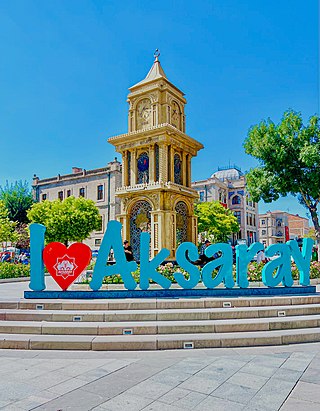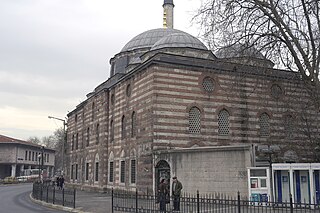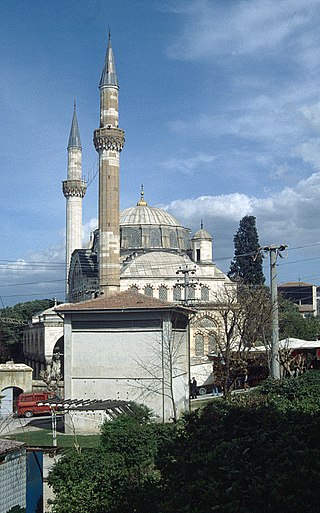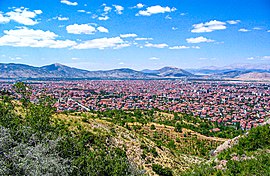
Mimar Sinan also known as Koca Mi'mâr Sinân Âğâ, was the chief Ottoman architect, engineer and mathematician for sultans Suleiman the Magnificent, Selim II and Murad III. He was responsible for the construction of more than 300 major structures, including the Selimiye Mosque in Edirne, the Kanuni Sultan Suleiman Bridge in Büyükçekmece, and the Mehmed Paša Sokolović Bridge in Višegrad, as well as other more modest projects such as madrasa's, külliyes, and bridges. His apprentices would later design the Sultan Ahmed Mosque in Istanbul and the Stari Most bridge in Mostar.

Aksaray is a city in the Central Anatolia region of Turkey. It is the seat of Aksaray Province and Aksaray District. Its population is 247,147 (2021). In 2021 the province had an estimated population of 429,069 distributed over about 7,659 km2 (2,957 sq mi). The average elevation is 980 m (3,215 ft), with the highest point being Mt. Hasan at 3,268 m (10,722 ft).

Fatih is a municipality and district of Istanbul Province, Turkey. Its area is 15 km2, and its population is 368,227 (2022). It is home to almost all of the provincial authorities but not the courthouse. It encompasses the historical peninsula, coinciding with old Constantinople. In 2009, the district of Eminönü, which had been a separate municipality located at the tip of the peninsula, was once again remerged into Fatih because of its small population. Fatih is bordered by the Golden Horn to the north and the Sea of Marmara to the south, while the Western border is demarked by the Theodosian wall and the east by the Bosphorus Strait.

Büyükçekmece, historically Athyras is a municipality and district of Istanbul Province, Turkey. Its area is 173 km2, and its population is 277,181 (2022). It is on the Sea of Marmara coast of the European side, west of the city. It is largely an industrial area. The mayor is Hasan Akgün (CHP).

Burdur is a city in southwestern Turkey. The seat of Burdur Province and of Burdur District, it is located on the shore of Lake Burdur. Its population is 95,436 (2021).

Kütahya is a city in western Turkey which lies on the Porsuk River, at 969 metres above sea level. It is the seat of Kütahya Province and Kütahya District. Its population is 263,863 (2022). The region of Kütahya has large areas of gentle slopes with agricultural land culminating in high mountain ridges to the north and west.

Babaeski is a town in Kırklareli Province in the Marmara region of Turkey. It is the seat of Babaeski District. Its population is 29,215 (2022).
This page is a list of places of interest in Bursa Province, Turkey.

Rüstem Pasha was an Ottoman statesman who served as Grand Vizier to Sultan Süleyman the Magnificent. Rüstem Pasha is also known as Damat Rüstem Pasha as a result of his marriage to the sultan's daughter, Mihrimah Sultan, in 1539. He is regarded as one of the most influential and successful grand viziers of the Ottoman Empire.

The Sinan Pasha Mosque is an Ottoman mosque located in a densely populated district of Beşiktaş, in Istanbul, Turkey. It was built by the Ottoman architect Mimar Sinan for the admiral Sinan Pasha. The türbe (tomb) of Barbaros Hayrettin Pasha is located just across the street.
Sultanzade Şemsi Ahmed Pasha, known simply as Şemsi Pasha, was a distinguished Ottoman nobleman and beylerbey who occupied several high-ranking posts, serving at various stages as the Ottoman governor-general of the beylerbeyliks of Damascus, Anatolia and Rumeli.

Milas is a municipality and district of Muğla Province, Turkey. Its area is 2,067 km2, and its population is 147,416 (2022). The city commands a region with an active economy and is very rich in history and ancient remains, the territory of Milas containing a remarkable twenty-seven archaeological sites of note. The city was the first capital of ancient Caria and of the Anatolian beylik of Menteşe in mediaeval times. The nearby Mausoleum of Hecatomnus is classified as a tentative UNESCO World Heritage Site.

The Hadim Ibrahim Pasha Mosque is a 16th-century Ottoman mosque located in the Silivrikapi neighborhood of Istanbul, Turkey.

The Muradiye Mosque is a 16th-century Ottoman mosque in the town of Manisa in southwest Turkey. It was commissioned by the sultan Murad III and designed by the imperial architect Mimar Sinan.

Pertev Mehmet Paşa Mosque, also known as Yeni Cuma Cami meaning "New Friday Mosque" in Turkish, is a 16th-century Ottoman mosque in the town of Izmit, Turkey. The architect was Mimar Sinan. It was built for Pertev Mehmed Paşa, an Ottoman vizier during the reigns of sultan Suleyman I and Selim II. The construction was finished in 1579. The mosque is part of a larger complex (Külliye) which originally included a madrasa, hammam, caravanserai, fountain and a lower education school. The mosque itself is a single domed structure and the dome has 24 windows. The minaret was damaged during the 1999 İzmit earthquake.

Kanlıca is a neighbourhood in the municipality and district of Beykoz, Istanbul Province, Turkey. Its population is 3,943 (2022). It is on the Asian side of the Bosphorus strait. It is known for a yogurt sprinkled with caster sugar, which is sold in local cafés, including the İsmailağa Kahvesi which has a small museum commemorating famous visitors of the past.

İskender Pasha Mosque is a historic mosque located in the Kanlıca neighborhood of the Beykoz district of Istanbul, Turkey.

The Sokollu Mehmed Pasha Mosque is a 16th-century Ottoman mosque located in Istanbul, Turkey.

The Sokollu Mehmed Pasha Mosque, also known as the Köprübaşı (Bridgehead) Mosque, is the ruin of a 16th-century Ottoman mosque located in Istanbul, Turkey.
The Sokollu Mehmed Pasha Mosque is a 16th-century Ottoman mosque located in the town of Lüleburgaz in the Kırklareli Province of northwestern Turkey.









































